Adolescent PTSD: A Nursing Case Study on Effective Therapies
VerifiedAdded on 2023/06/12
|7
|1738
|107
Case Study
AI Summary
This case study focuses on a 14-year-old boy named John suffering from post-traumatic stress disorder (PTSD) due to his father's abusive behavior and his parents' recent divorce. It synthesizes the concept of adolescent development and the impact of traumatic events on mental health. The study explores the application of cognitive behavior therapy and cognitive processing theory as potential interventions, emphasizing the importance of creating a comfortable and trusting environment for the patient. It also highlights the crucial role of nurses in supporting patients with PTSD, including encouraging open communication, providing emotional support to families, and facilitating access to necessary resources and therapies. The case study concludes by underscoring the significance of addressing PTSD to prevent negative emotional and psychological outcomes.
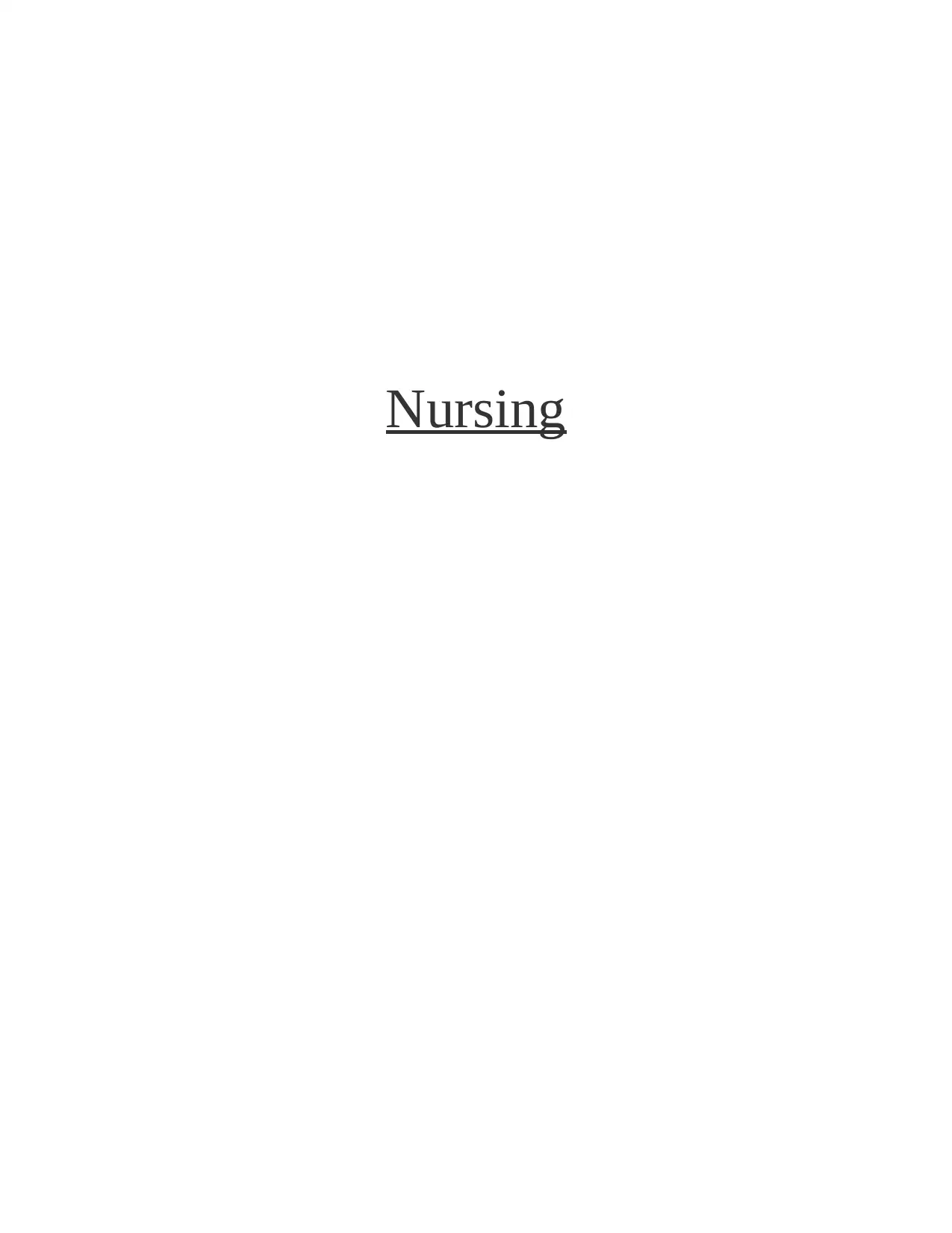
Nursing
Paraphrase This Document
Need a fresh take? Get an instant paraphrase of this document with our AI Paraphraser
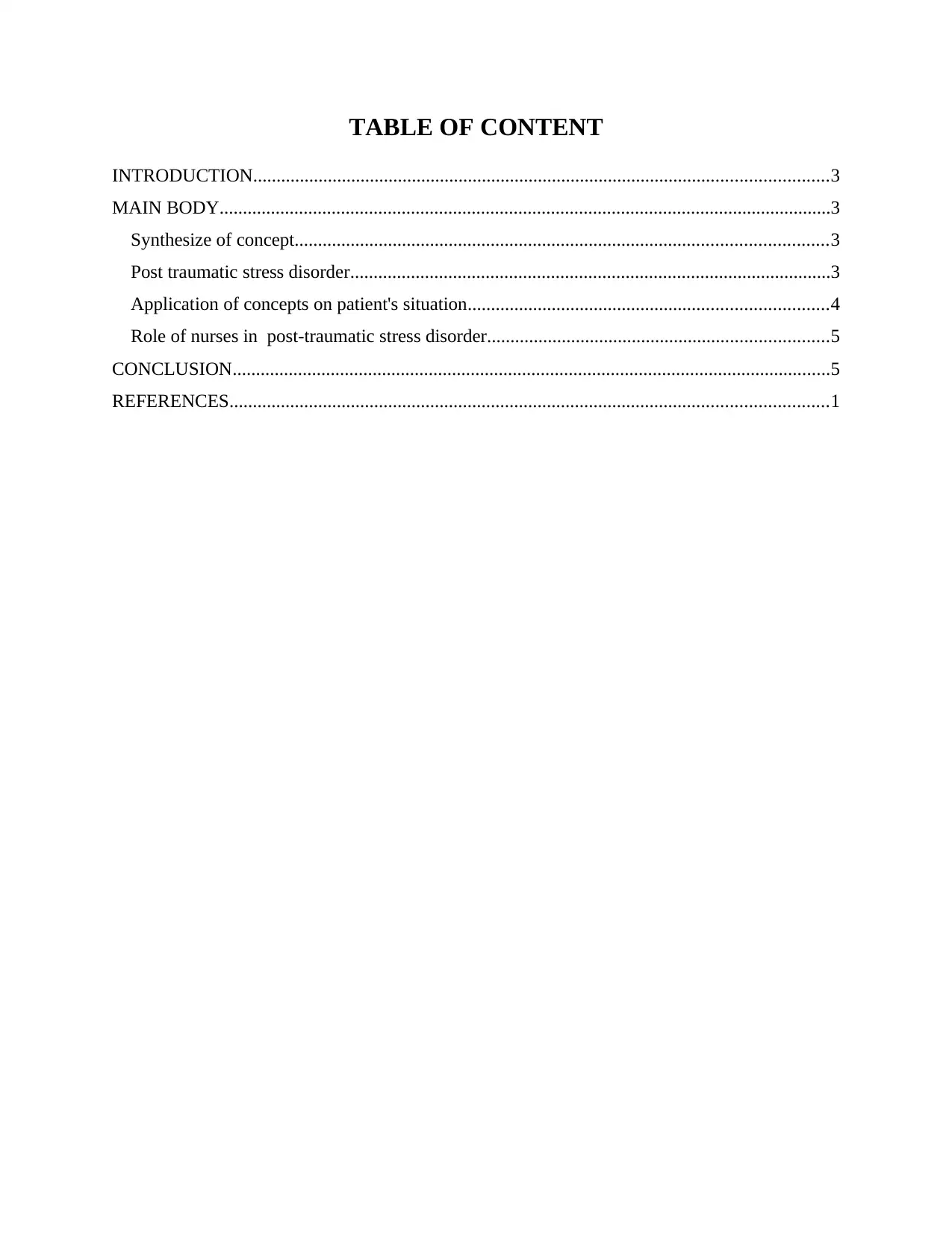
TABLE OF CONTENT
INTRODUCTION...........................................................................................................................3
MAIN BODY...................................................................................................................................3
Synthesize of concept..................................................................................................................3
Post traumatic stress disorder.......................................................................................................3
Application of concepts on patient's situation.............................................................................4
Role of nurses in post-traumatic stress disorder.........................................................................5
CONCLUSION................................................................................................................................5
REFERENCES................................................................................................................................1
INTRODUCTION...........................................................................................................................3
MAIN BODY...................................................................................................................................3
Synthesize of concept..................................................................................................................3
Post traumatic stress disorder.......................................................................................................3
Application of concepts on patient's situation.............................................................................4
Role of nurses in post-traumatic stress disorder.........................................................................5
CONCLUSION................................................................................................................................5
REFERENCES................................................................................................................................1
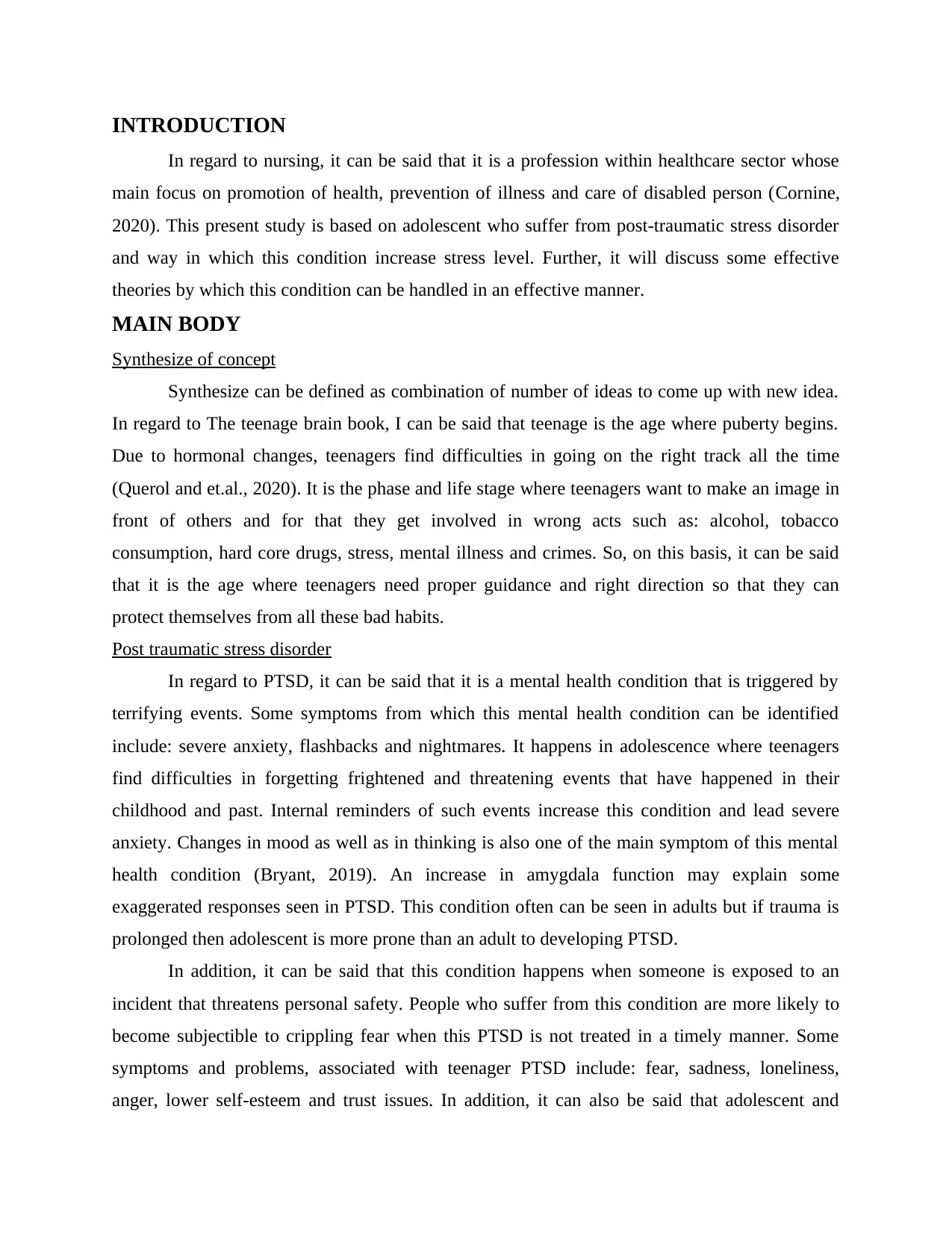
INTRODUCTION
In regard to nursing, it can be said that it is a profession within healthcare sector whose
main focus on promotion of health, prevention of illness and care of disabled person (Cornine,
2020). This present study is based on adolescent who suffer from post-traumatic stress disorder
and way in which this condition increase stress level. Further, it will discuss some effective
theories by which this condition can be handled in an effective manner.
MAIN BODY
Synthesize of concept
Synthesize can be defined as combination of number of ideas to come up with new idea.
In regard to The teenage brain book, I can be said that teenage is the age where puberty begins.
Due to hormonal changes, teenagers find difficulties in going on the right track all the time
(Querol and et.al., 2020). It is the phase and life stage where teenagers want to make an image in
front of others and for that they get involved in wrong acts such as: alcohol, tobacco
consumption, hard core drugs, stress, mental illness and crimes. So, on this basis, it can be said
that it is the age where teenagers need proper guidance and right direction so that they can
protect themselves from all these bad habits.
Post traumatic stress disorder
In regard to PTSD, it can be said that it is a mental health condition that is triggered by
terrifying events. Some symptoms from which this mental health condition can be identified
include: severe anxiety, flashbacks and nightmares. It happens in adolescence where teenagers
find difficulties in forgetting frightened and threatening events that have happened in their
childhood and past. Internal reminders of such events increase this condition and lead severe
anxiety. Changes in mood as well as in thinking is also one of the main symptom of this mental
health condition (Bryant, 2019). An increase in amygdala function may explain some
exaggerated responses seen in PTSD. This condition often can be seen in adults but if trauma is
prolonged then adolescent is more prone than an adult to developing PTSD.
In addition, it can be said that this condition happens when someone is exposed to an
incident that threatens personal safety. People who suffer from this condition are more likely to
become subjectible to crippling fear when this PTSD is not treated in a timely manner. Some
symptoms and problems, associated with teenager PTSD include: fear, sadness, loneliness,
anger, lower self-esteem and trust issues. In addition, it can also be said that adolescent and
In regard to nursing, it can be said that it is a profession within healthcare sector whose
main focus on promotion of health, prevention of illness and care of disabled person (Cornine,
2020). This present study is based on adolescent who suffer from post-traumatic stress disorder
and way in which this condition increase stress level. Further, it will discuss some effective
theories by which this condition can be handled in an effective manner.
MAIN BODY
Synthesize of concept
Synthesize can be defined as combination of number of ideas to come up with new idea.
In regard to The teenage brain book, I can be said that teenage is the age where puberty begins.
Due to hormonal changes, teenagers find difficulties in going on the right track all the time
(Querol and et.al., 2020). It is the phase and life stage where teenagers want to make an image in
front of others and for that they get involved in wrong acts such as: alcohol, tobacco
consumption, hard core drugs, stress, mental illness and crimes. So, on this basis, it can be said
that it is the age where teenagers need proper guidance and right direction so that they can
protect themselves from all these bad habits.
Post traumatic stress disorder
In regard to PTSD, it can be said that it is a mental health condition that is triggered by
terrifying events. Some symptoms from which this mental health condition can be identified
include: severe anxiety, flashbacks and nightmares. It happens in adolescence where teenagers
find difficulties in forgetting frightened and threatening events that have happened in their
childhood and past. Internal reminders of such events increase this condition and lead severe
anxiety. Changes in mood as well as in thinking is also one of the main symptom of this mental
health condition (Bryant, 2019). An increase in amygdala function may explain some
exaggerated responses seen in PTSD. This condition often can be seen in adults but if trauma is
prolonged then adolescent is more prone than an adult to developing PTSD.
In addition, it can be said that this condition happens when someone is exposed to an
incident that threatens personal safety. People who suffer from this condition are more likely to
become subjectible to crippling fear when this PTSD is not treated in a timely manner. Some
symptoms and problems, associated with teenager PTSD include: fear, sadness, loneliness,
anger, lower self-esteem and trust issues. In addition, it can also be said that adolescent and
⊘ This is a preview!⊘
Do you want full access?
Subscribe today to unlock all pages.

Trusted by 1+ million students worldwide
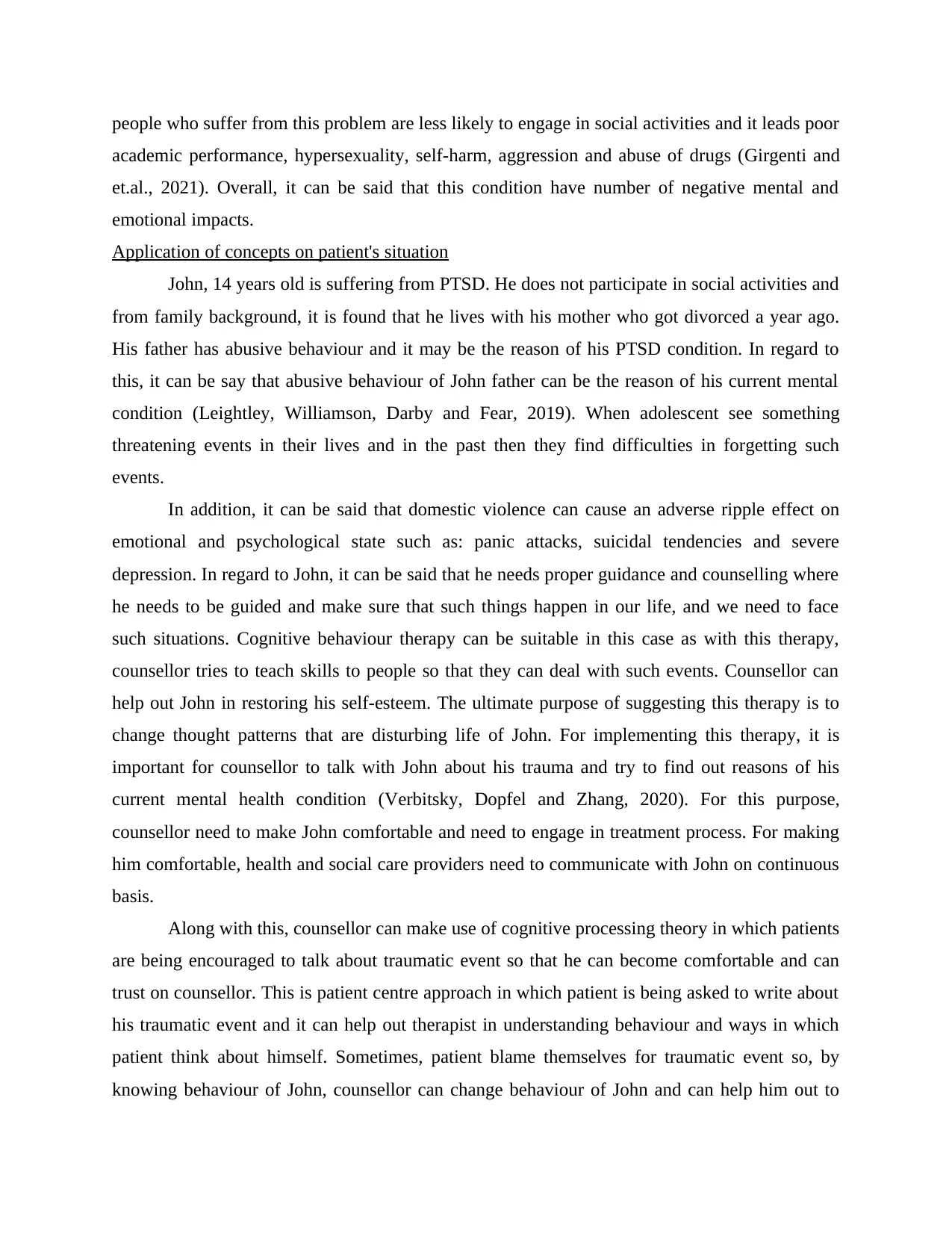
people who suffer from this problem are less likely to engage in social activities and it leads poor
academic performance, hypersexuality, self-harm, aggression and abuse of drugs (Girgenti and
et.al., 2021). Overall, it can be said that this condition have number of negative mental and
emotional impacts.
Application of concepts on patient's situation
John, 14 years old is suffering from PTSD. He does not participate in social activities and
from family background, it is found that he lives with his mother who got divorced a year ago.
His father has abusive behaviour and it may be the reason of his PTSD condition. In regard to
this, it can be say that abusive behaviour of John father can be the reason of his current mental
condition (Leightley, Williamson, Darby and Fear, 2019). When adolescent see something
threatening events in their lives and in the past then they find difficulties in forgetting such
events.
In addition, it can be said that domestic violence can cause an adverse ripple effect on
emotional and psychological state such as: panic attacks, suicidal tendencies and severe
depression. In regard to John, it can be said that he needs proper guidance and counselling where
he needs to be guided and make sure that such things happen in our life, and we need to face
such situations. Cognitive behaviour therapy can be suitable in this case as with this therapy,
counsellor tries to teach skills to people so that they can deal with such events. Counsellor can
help out John in restoring his self-esteem. The ultimate purpose of suggesting this therapy is to
change thought patterns that are disturbing life of John. For implementing this therapy, it is
important for counsellor to talk with John about his trauma and try to find out reasons of his
current mental health condition (Verbitsky, Dopfel and Zhang, 2020). For this purpose,
counsellor need to make John comfortable and need to engage in treatment process. For making
him comfortable, health and social care providers need to communicate with John on continuous
basis.
Along with this, counsellor can make use of cognitive processing theory in which patients
are being encouraged to talk about traumatic event so that he can become comfortable and can
trust on counsellor. This is patient centre approach in which patient is being asked to write about
his traumatic event and it can help out therapist in understanding behaviour and ways in which
patient think about himself. Sometimes, patient blame themselves for traumatic event so, by
knowing behaviour of John, counsellor can change behaviour of John and can help him out to
academic performance, hypersexuality, self-harm, aggression and abuse of drugs (Girgenti and
et.al., 2021). Overall, it can be said that this condition have number of negative mental and
emotional impacts.
Application of concepts on patient's situation
John, 14 years old is suffering from PTSD. He does not participate in social activities and
from family background, it is found that he lives with his mother who got divorced a year ago.
His father has abusive behaviour and it may be the reason of his PTSD condition. In regard to
this, it can be say that abusive behaviour of John father can be the reason of his current mental
condition (Leightley, Williamson, Darby and Fear, 2019). When adolescent see something
threatening events in their lives and in the past then they find difficulties in forgetting such
events.
In addition, it can be said that domestic violence can cause an adverse ripple effect on
emotional and psychological state such as: panic attacks, suicidal tendencies and severe
depression. In regard to John, it can be said that he needs proper guidance and counselling where
he needs to be guided and make sure that such things happen in our life, and we need to face
such situations. Cognitive behaviour therapy can be suitable in this case as with this therapy,
counsellor tries to teach skills to people so that they can deal with such events. Counsellor can
help out John in restoring his self-esteem. The ultimate purpose of suggesting this therapy is to
change thought patterns that are disturbing life of John. For implementing this therapy, it is
important for counsellor to talk with John about his trauma and try to find out reasons of his
current mental health condition (Verbitsky, Dopfel and Zhang, 2020). For this purpose,
counsellor need to make John comfortable and need to engage in treatment process. For making
him comfortable, health and social care providers need to communicate with John on continuous
basis.
Along with this, counsellor can make use of cognitive processing theory in which patients
are being encouraged to talk about traumatic event so that he can become comfortable and can
trust on counsellor. This is patient centre approach in which patient is being asked to write about
his traumatic event and it can help out therapist in understanding behaviour and ways in which
patient think about himself. Sometimes, patient blame themselves for traumatic event so, by
knowing behaviour of John, counsellor can change behaviour of John and can help him out to
Paraphrase This Document
Need a fresh take? Get an instant paraphrase of this document with our AI Paraphraser
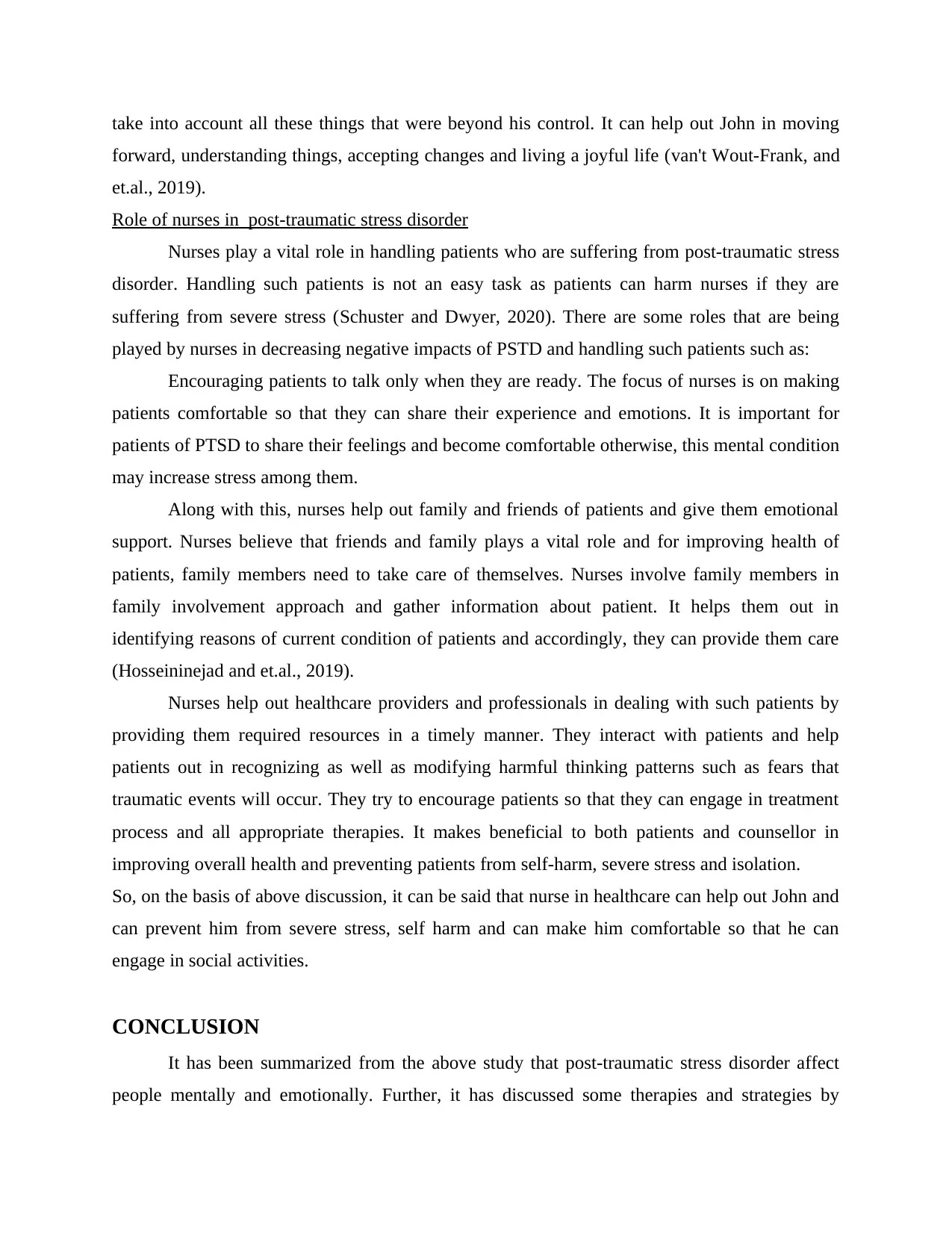
take into account all these things that were beyond his control. It can help out John in moving
forward, understanding things, accepting changes and living a joyful life (van't Wout-Frank, and
et.al., 2019).
Role of nurses in post-traumatic stress disorder
Nurses play a vital role in handling patients who are suffering from post-traumatic stress
disorder. Handling such patients is not an easy task as patients can harm nurses if they are
suffering from severe stress (Schuster and Dwyer, 2020). There are some roles that are being
played by nurses in decreasing negative impacts of PSTD and handling such patients such as:
Encouraging patients to talk only when they are ready. The focus of nurses is on making
patients comfortable so that they can share their experience and emotions. It is important for
patients of PTSD to share their feelings and become comfortable otherwise, this mental condition
may increase stress among them.
Along with this, nurses help out family and friends of patients and give them emotional
support. Nurses believe that friends and family plays a vital role and for improving health of
patients, family members need to take care of themselves. Nurses involve family members in
family involvement approach and gather information about patient. It helps them out in
identifying reasons of current condition of patients and accordingly, they can provide them care
(Hosseininejad and et.al., 2019).
Nurses help out healthcare providers and professionals in dealing with such patients by
providing them required resources in a timely manner. They interact with patients and help
patients out in recognizing as well as modifying harmful thinking patterns such as fears that
traumatic events will occur. They try to encourage patients so that they can engage in treatment
process and all appropriate therapies. It makes beneficial to both patients and counsellor in
improving overall health and preventing patients from self-harm, severe stress and isolation.
So, on the basis of above discussion, it can be said that nurse in healthcare can help out John and
can prevent him from severe stress, self harm and can make him comfortable so that he can
engage in social activities.
CONCLUSION
It has been summarized from the above study that post-traumatic stress disorder affect
people mentally and emotionally. Further, it has discussed some therapies and strategies by
forward, understanding things, accepting changes and living a joyful life (van't Wout-Frank, and
et.al., 2019).
Role of nurses in post-traumatic stress disorder
Nurses play a vital role in handling patients who are suffering from post-traumatic stress
disorder. Handling such patients is not an easy task as patients can harm nurses if they are
suffering from severe stress (Schuster and Dwyer, 2020). There are some roles that are being
played by nurses in decreasing negative impacts of PSTD and handling such patients such as:
Encouraging patients to talk only when they are ready. The focus of nurses is on making
patients comfortable so that they can share their experience and emotions. It is important for
patients of PTSD to share their feelings and become comfortable otherwise, this mental condition
may increase stress among them.
Along with this, nurses help out family and friends of patients and give them emotional
support. Nurses believe that friends and family plays a vital role and for improving health of
patients, family members need to take care of themselves. Nurses involve family members in
family involvement approach and gather information about patient. It helps them out in
identifying reasons of current condition of patients and accordingly, they can provide them care
(Hosseininejad and et.al., 2019).
Nurses help out healthcare providers and professionals in dealing with such patients by
providing them required resources in a timely manner. They interact with patients and help
patients out in recognizing as well as modifying harmful thinking patterns such as fears that
traumatic events will occur. They try to encourage patients so that they can engage in treatment
process and all appropriate therapies. It makes beneficial to both patients and counsellor in
improving overall health and preventing patients from self-harm, severe stress and isolation.
So, on the basis of above discussion, it can be said that nurse in healthcare can help out John and
can prevent him from severe stress, self harm and can make him comfortable so that he can
engage in social activities.
CONCLUSION
It has been summarized from the above study that post-traumatic stress disorder affect
people mentally and emotionally. Further, it has discussed some therapies and strategies by

which PTSD mental condition can be solved such as: cognitive behaviour and cognitive
processing theory.
processing theory.
⊘ This is a preview!⊘
Do you want full access?
Subscribe today to unlock all pages.

Trusted by 1+ million students worldwide
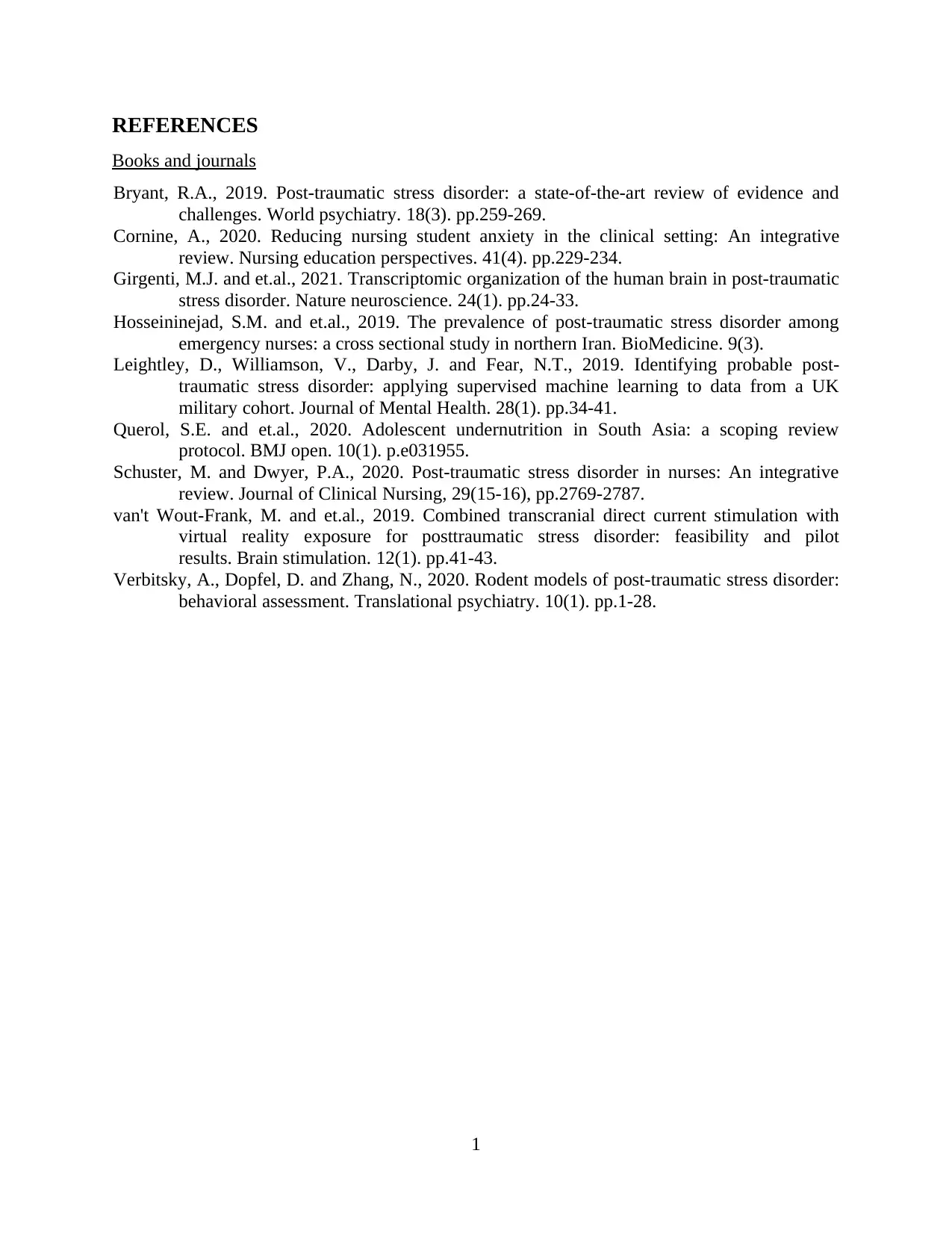
REFERENCES
Books and journals
Bryant, R.A., 2019. Post‐traumatic stress disorder: a state‐of‐the‐art review of evidence and
challenges. World psychiatry. 18(3). pp.259-269.
Cornine, A., 2020. Reducing nursing student anxiety in the clinical setting: An integrative
review. Nursing education perspectives. 41(4). pp.229-234.
Girgenti, M.J. and et.al., 2021. Transcriptomic organization of the human brain in post-traumatic
stress disorder. Nature neuroscience. 24(1). pp.24-33.
Hosseininejad, S.M. and et.al., 2019. The prevalence of post-traumatic stress disorder among
emergency nurses: a cross sectional study in northern Iran. BioMedicine. 9(3).
Leightley, D., Williamson, V., Darby, J. and Fear, N.T., 2019. Identifying probable post-
traumatic stress disorder: applying supervised machine learning to data from a UK
military cohort. Journal of Mental Health. 28(1). pp.34-41.
Querol, S.E. and et.al., 2020. Adolescent undernutrition in South Asia: a scoping review
protocol. BMJ open. 10(1). p.e031955.
Schuster, M. and Dwyer, P.A., 2020. Post‐traumatic stress disorder in nurses: An integrative
review. Journal of Clinical Nursing, 29(15-16), pp.2769-2787.
van't Wout-Frank, M. and et.al., 2019. Combined transcranial direct current stimulation with
virtual reality exposure for posttraumatic stress disorder: feasibility and pilot
results. Brain stimulation. 12(1). pp.41-43.
Verbitsky, A., Dopfel, D. and Zhang, N., 2020. Rodent models of post-traumatic stress disorder:
behavioral assessment. Translational psychiatry. 10(1). pp.1-28.
1
Books and journals
Bryant, R.A., 2019. Post‐traumatic stress disorder: a state‐of‐the‐art review of evidence and
challenges. World psychiatry. 18(3). pp.259-269.
Cornine, A., 2020. Reducing nursing student anxiety in the clinical setting: An integrative
review. Nursing education perspectives. 41(4). pp.229-234.
Girgenti, M.J. and et.al., 2021. Transcriptomic organization of the human brain in post-traumatic
stress disorder. Nature neuroscience. 24(1). pp.24-33.
Hosseininejad, S.M. and et.al., 2019. The prevalence of post-traumatic stress disorder among
emergency nurses: a cross sectional study in northern Iran. BioMedicine. 9(3).
Leightley, D., Williamson, V., Darby, J. and Fear, N.T., 2019. Identifying probable post-
traumatic stress disorder: applying supervised machine learning to data from a UK
military cohort. Journal of Mental Health. 28(1). pp.34-41.
Querol, S.E. and et.al., 2020. Adolescent undernutrition in South Asia: a scoping review
protocol. BMJ open. 10(1). p.e031955.
Schuster, M. and Dwyer, P.A., 2020. Post‐traumatic stress disorder in nurses: An integrative
review. Journal of Clinical Nursing, 29(15-16), pp.2769-2787.
van't Wout-Frank, M. and et.al., 2019. Combined transcranial direct current stimulation with
virtual reality exposure for posttraumatic stress disorder: feasibility and pilot
results. Brain stimulation. 12(1). pp.41-43.
Verbitsky, A., Dopfel, D. and Zhang, N., 2020. Rodent models of post-traumatic stress disorder:
behavioral assessment. Translational psychiatry. 10(1). pp.1-28.
1
1 out of 7
Related Documents
Your All-in-One AI-Powered Toolkit for Academic Success.
+13062052269
info@desklib.com
Available 24*7 on WhatsApp / Email
![[object Object]](/_next/static/media/star-bottom.7253800d.svg)
Unlock your academic potential
Copyright © 2020–2025 A2Z Services. All Rights Reserved. Developed and managed by ZUCOL.





